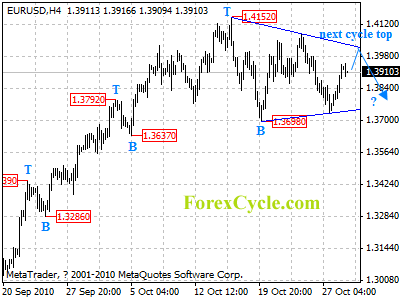Source: ForexYard
The U.S dollar weakened for the first time in three days against the euro in overnight trading, as Asian stocks gained amid optimism the global economic recovery remains intact, damping demand for the greenback as a refuge.
Economic News
USD – Dollar Rebounds Ahead of Fed’s Meeting
The U.S currency rose against the euro and yen on Wednesday, leaving the dollar index little changed year to date, as investors eased short bets against the currency ahead of a Federal Reserve meeting. The greenback extended its advance after stocks steepened their decline and a report showed new-home sales in the U.S. accelerated last month.
Analysts noted the improvement came off of historically low levels.
Earlier in the U.S. session, the dollar briefly pared its gains after a report on orders placed for durable goods during September indicated manufacturing and business spending may be slowing. However the dollar may strengthen further in the next days before next week’s interest-rate decision by the Federal Reserve, should economic data show better than forecasted outcomes.
EUR – Euro Falls To Session Low vs. Dollar
The euro fell to a session low against the dollar on Wednesday amid broad dollar strength as investors reduced short bets against the U.S. currency ahead of a Federal Reserve meeting next week.
The euro weakened after the results for the European Central Bank’s latest liquidity operation showed a larger than expected take up from European banks for cheap funding. The single currency fell as low as $1.3758 and was last down 0.6 percent at $1.3770.
Analysts believe the gap between euro-zone and U.S. short term rates, reflecting QE expectations from the Fed while the ECB gradually withdraws liquidity, will mean the euro is unlikely to fall below $1.36 in the next week or two particularly while investors wait to see the impact of the Fed measures.
JPY – The Yen Falls to 2 Week Low vs. Dollar
Japans’ currency fell as low as 81.98 against the U.S dollar, pulling further away from a 15-year high of 80.41 struck earlier this week. The Bank of Japan needs to do more to curb the yen’s advance by increasing its purchases of government bonds with longer maturities, according to Merrill Lynch Japan Securities Co.
The Japanese currency is approaching a post-war record of 79.75 against the dollar, threatening the nation’s export-led recovery. Should the yen rise to between 70 and 75 against the dollar and increase deflationary pressure, that could force companies to shift production abroad and cut jobs and business investment, economist said. According to analysts, it is very important for Japanese authorities to take measures to stabilize the yen between 85 and 90 against the USD.
Crude Oil – Oil Declines below $82 on Stronger Dollar
Oil prices slid nearly 1% on Wednesday, pressured by a rally in the dollar as doubts increased among investors about the size of a much talked about U.S. economic stimulus move by the Federal Reserve. The U.S government data that showed a surprise drawdown of 4.4 million barrels in gasoline stocks last week, against forecasts that motor fuel supplies rose, helped limit losses.
Overall, the latest data that showed that domestic crude inventories fell 5 million barrels, much more than forecast, though less than Tuesday’s industry report of a 6.4-million-barrel increase, disappointed investors. The negative correlation between the dollar and the price of oil was near its strongest level in 14 months in the run-up to the Fed meeting on November 2-3, when it is expected to detail how much money will be pumped into the U.S. economy.
A stronger dollar can pressure oil prices by making dollar-denominated oil dearer to users of other currencies and by pulling investment into other markets from commodities, which are viewed as riskier bets.
Technical News
EUR/USD
The pair’s recent upward correction may have been over extended as the pair’s RSI is seen floating in the overbought territory on the daily and 4 hour charts. Going short with tight stops might be advised for today.
GBP/USD
The daily chart is showing mixed signals with its RSI fluctuating in neutral territory. However, there is a fresh bearish cross forming on the 4-hour chart’s Slow Stochastic indicating a bearish correction might take place in the near future. Going short might be a wise choice.
USD/JPY
The hourly chart displays the Bollinger Bands tightening, indicating a breakout may occur in the near term. It can be inferred from the chart that the breakout will be to the upside as a bullish cross has formed on the Slow Stochastic Oscillator. The RSI-14 is also positive sloping, indicating that the momentum is to the upside. Traders should wait for the breakout and go long.
USD/CHF
The cross has recently recorded a 2-day losing streak, and there are signs for further volatility for the pair today. The RSI on the daily chart shows the pair sitting in oversold territory. On the other hand, the RSI on the weekly chart shows that the pair is overbought. It may be a good idea to enter the pair when the signals are clearer.
The Wild Card
AUD/USD
The AUD/USD sustained upward movement and has finally pushed its price into overbought territory on the daily chart’s RSI. Not only that, but there actually appears to be a bearish cross on the Slow Stochastic pointing to an imminent downward correction. Forex traders have the opportunity to wait for the downward breach on the hourlies and go short in order to ride out the impending wave.
Forex Market Analysis provided by ForexYard.
© 2006 by FxYard Ltd
Disclaimer: Trading Foreign Exchange carries a high level of risk and may not be suitable for all investors. There is a possibility that you could sustain a loss of all of your investment and therefore you should not invest money that you cannot afford to lose. You should be aware of all the risks associated with Foreign Exchange trading.



